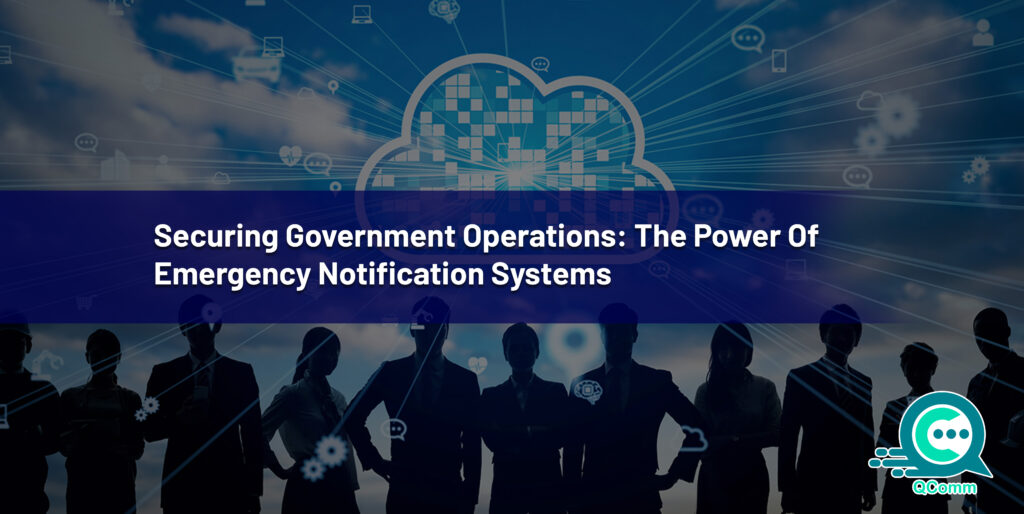
In the wake of a crisis, words matter as much as actions. A well-crafted message can calm a crowd, reassure stakeholders, and even save lives. But many organizations still treat communication as a mere checkbox—a requirement to tick off for compliance rather than a powerful tool for connection.
According to a 2024 FEMA report, 67% of crisis communication plans fail to resonate with their intended audience, resulting in confusion, panic, and distrust. The challenge is not just to deliver a message but to ensure that it lands effectively.
Table of Contents:
- Humanizing Communication: Making It Relatable, Not Robotic
- Compliance vs. Connection: The Critical Difference
- The Ripple Effect: How Poor Communication Worsens a Crisis
- The QComm Edge: From Alerts to Accountability
- Building a Communication-First Culture
- Why Context Matters: Crafting Targeted Messages
- Building Trust Before, During, and After a Crisis
- QComm’s Approach: Integrating Empathy with Efficiency
- The Takeaway: Communication That Resonates
Humanizing Communication: Making It Relatable, Not Robotic
Effective crisis communication isn’t just about issuing instructions; it’s about making the information relatable and actionable. Think of how Apple’s emergency alerts are concise but impactful: ‘Stay indoors. Close windows. Air quality is hazardous.’
“In a crisis, the goal isn’t just to inform—it’s to connect.”
Compliance vs. Connection: The Critical Difference
Compliance-based communication checks the boxes but misses the mark on empathy. It’s factual, procedural, and often robotic. But in a crisis, people need more than facts—they need assurance, direction, and empathy.
A checklist might cover protocols, but it doesn’t guarantee clarity, speed, or effectiveness when lives are on the line.
Take, for instance, the 2023 evacuation of a commercial building in Texas. Despite having a comprehensive checklist, outdated communication channels left 24% of occupants unaware of the evacuation order. The incident underscores a crucial lesson: checklists are static, but crises are dynamic
The Ripple Effect: How Poor Communication Worsens a Crisis
Misinformation can spread like wildfire in a crisis, compounding fear and causing unnecessary harm. During an emergency, people need clear, actionable instructions delivered through multiple, synchronized channels.
Imagine a fire breaking out in a multi-story office building. The alarm sounds, but the evacuation plan only considers primary exits. What about areas with blocked stairways? What if certain floors are more affected? This is where QComm steps in, transforming a static checklist into a dynamic communication strategy.
This underscores the importance of clear, consistent messaging that is accessible to all—regardless of language, literacy, or access to technology.
QComm’s platform ensures that every message is tailored to specific risk zones and personnel roles. With features like:
- Instant Multi-Channel Alerts: SMS, email, in-app notifications, and digital signage all delivering consistent, timely updates.
- Real-Time Dashboards: Crisis coordinators monitor evacuee status in real time, ensuring no one is left behind.
Automated Follow-Up: Post-incident reports and analytics provide actionable insights to refine future protocols.
The QComm Edge: From Alerts to Accountability
QComm is more than a notification system – it’s a comprehensive communication framework designed to transform data into action. By integrating with existing security systems, it connects all communication channels, ensuring a unified response.
For instance, during a 2024 cyber-attack simulation conducted by a financial firm, QComm was instrumental in preventing data breaches by coordinating IT alerts, security lockdowns, and staff notifications—all within 10 minutes.

Building a Communication-First Culture
Organizations often treat communication as a checkbox, not a core competency. But in a crisis, communication can’t be reactive—it must be proactive, precise, and people-centered.
Start by reframing communication as a continuous, evolving process. Regular drills, scenario-based training, and post-incident reviews are crucial. QComm makes this easier by automating drills and aggregating data, allowing teams to assess their response times and identify weaknesses.
But it’s not just about the tools. It’s about building a culture where communication is valued, practiced, and refined. Employees at every level should be empowered to respond confidently and correctly, reducing confusion and reinforcing trust.
Why Context Matters: Crafting Targeted Messages
Blanket messaging doesn’t work in a crisis. Different audiences require different messages:
- Employees may need detailed action plans.
- Visitors need quick, clear evacuation routes.
- Stakeholders need reassurance and impact analysis.
QComm’s platform allows for segmented messaging, ensuring that each audience receives the most relevant information based on their location and role.
Building Trust Before, During, and After a Crisis
Communication isn’t just a crisis-time activity—it’s an ongoing strategy. Organizations that build rapport with their audience before a crisis can leverage that trust when a crisis hits.
For instance, a major retailer that consistently communicated safety tips during normal operations successfully maintained customer trust during a 2024 data breach by continuing the same transparent, informative tone.
QComm’s Approach: Integrating Empathy with Efficiency
Rather than treating communication as an afterthought, QComm integrates real-time alerts with contextual messaging, ensuring that the right people get the right message at the right time.

The Takeaway: Communication That Resonates
In emergencies, clarity saves lives. Organizations that move beyond checklists to craft empathetic, impactful communication not only protect their stakeholders but also reinforce their brand’s commitment to safety and care.
Secure Your Communication Strategy with QComm
Don’t let your communication strategy fall short when it matters most. Explore how QComm’s crisis communication solutions can transform your approach from mere compliance to true connection.
Book a demo today or contact our team to learn more.


